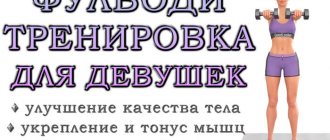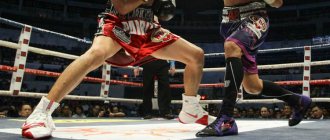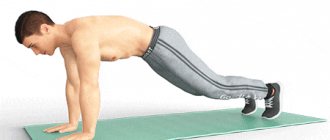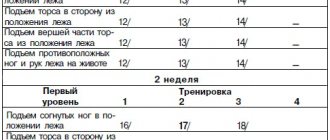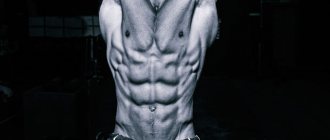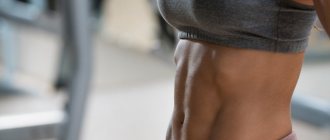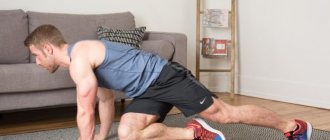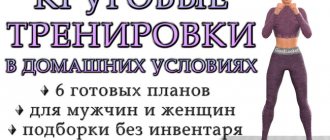To look attractive, girls often make a lot of effort - they do hard workouts, stick to a diet, and follow their daily routine. If you don't have time to go to the gym, you can do the exercises at home. To do this, you don’t need special equipment or heavy dumbbells - just lay out a mat or lie down on a regular mat and start training. You should start doing the exercises with a warm-up, and then gradually move on to the training complex.
Hyperextension
Let's start by warming up the back muscles. To do this, lie on your stomach, place your hands behind your head and lock them together. Elbows spread to the sides, head down, legs connected. Now lift your upper body, trying to arch your lower back. Lower yourself down without putting your head on the floor. Repeat the movement.
Number of repetitions – 2 sets of 20 times.
Advice. Do not make sudden movements; the exercise is performed smoothly.
Contraindications. Pain in the back, shoulders, problems in the cervical spine.
Benefits of Strength Training for Weight Loss
The goals of a person losing weight are to reduce their size and increase the attractiveness of their figure.
To do this, he most often resorts to long-term aerobic exercise, such as running, cycling or swimming. Fear of strength training among those wishing to lose weight is primarily associated with an increase in muscle mass. However, they are the ones that will help increase basal metabolism, avoid re-accumulation of fat, draw beautiful muscle definition, and most importantly, move off the plateau in weight loss or training. The larger the muscles, the greater the amount of calories burned, even at rest. Strength training will not only help you burn a lot of energy during exercise, but it will also prime your body to burn more calories after your workout. Such exercises improve tendon strength, bone density, and form a muscle corset that provides postural support for the skeleton. And don’t be afraid to pump yourself up to the size of a professional athlete—it’s impossible to achieve this effect at home, without exercise equipment and sports nutrition to build muscles.
To master the correct strength training technique, it is better to contact a professional trainer, but there are situations when personal consultation and training in the gym are not possible. In this case, you need to create a program yourself, without using special equipment.
Plank
From a lying position, rise onto your forearms and toes, straighten your knees. The back should be straight, the lower back should not bend. Direct your gaze straight ahead. You need to hold out in this position for at least a minute.
Number of repetitions – 2 sets of 60 seconds.
Advice. Breathing should be free, your back should be straight, try not to arch your lower back and keep your abs tense.
Contraindications. Hernias, sharp pain in the lower back.
Cardio training
Burpee
If you have to choose only one cardio exercise, then the choice should be made in favor of burpees, because it involves all the muscles of the body from head to toe and allows you to burn more calories in one minute than any other. But it must be done correctly or not at all!
8 cardio exercises without weights
These eight best exercises will help you speed up your metabolism so you'll never need cardio equipment again (unless you want to use them):
- Jumper
- Climber
- Skater
- kicking donkey
- Skier
- Brakedance
- Sprinter
- Woodcutter
In details
: Cardio exercises
Cardio without weights
This 20-minute weight-loss workout combines 8 core cardio exercises into one workout that burns calories like crazy. You can do it at home or in your hotel room. To achieve results as quickly as possible, it is better to perform this complex on the days between the fat burning program.
In details
:
Cardio workout
"Superman"
The starting position does not change - in the plank on the forearms. Now you need to straighten your left arm and raise your right leg above the floor. The arm and leg form a straight line, the back is straight. Repeat 15 arm and leg raises, then repeat the exercise for the right arm and left leg.
Number of repetitions – 2 sets of 15 repetitions for each hand.
Advice. Inhale at the beginning of the movement, exhale at maximum effort when the arm and leg are raised above the floor at the top point.
Contraindications. Back pain, injuries to shoulders, elbows and knees.
Day 3 – Back & Biceps
| Exercise | Approaches | Replays |
| Weighted pull-ups | 4 | 10/8/6/refusal |
| Bent-over barbell row | 3 | 12/10/8 |
| Bodyweight pull-ups with wide grip | 3 | 10-12 |
| Bent-over dumbbell row | 3 | 12 |
| Lifting dumbbells for biceps while sitting on an incline bench | 3 | 12 |
| Concentrated dumbbell curls for biceps | 3 | 10-12 |
| Exercise Hammer | 3 | 10-12 |
Day 4 - Rest
Reverse snow angel
Lie on your stomach, lift your upper body and legs off the floor. Now spread your arms out to the sides and swing them along your body, as if you were trying to draw a snow angel while lying on your back. The shoulder blades are brought together, the back is as tense as possible. Do 20 arm swings and lower yourself to the starting position. Repeat the exercise.
Number of repetitions – 2 sets of 20 times.
Advice. Try to perform the exercise smoothly. Breathe evenly, do not hold your breath.
Contraindications. Shoulder pain, back problems.
Can home workouts replace going to the gym?
Many people have doubts about the effectiveness of home workouts. Lack of motivation, desire, lack of exercise equipment and equipment, household chores are the main reasons. But the coach believes that working out at home is a good alternative to the gym.
Elena:
Working out at home can replace going to the gym if your training goals are achievable without equipment from the gym. And also, if you have the opportunity to regularly study at home and have the necessary equipment. Now we can say that it is not so much exercise that is important, but physical activity in general, so home workouts are in any case better than nothing.
Photo: istockphoto.com
"Boat"
Stay in the same position, lying on your stomach. Raise your upper body above the floor, stretch your arms forward. Raise your legs, knees should be straight. Look straight ahead. Hold in this position for 10 seconds. Get down to the floor.
Number of repetitions – 5 repetitions of 10 seconds.
Advice. Breathing should be smooth and free.
Contraindications. Hernias, pain in the shoulders or lower back, problems in the cervical spine.
Reduction of the shoulder blades
The starting position does not change - lying on your stomach, body raised above the floor. Bend your elbows and place your palms at chest level. Now try to bring your shoulder blades together as much as possible, moving your arms, bent at the elbows, back. Return your hands to the starting position.
Number of repetitions – 2 sets of 15 times.
Advice. At the moment of bringing your shoulder blades together, try to raise your body a little; when your hands return to the starting position, you can go lower.
Contraindications. Lower back pain, shoulder and neck problems.
Day 6 – Assisted Press & Shoulders
| Exercises | Approaches | Repetitions |
| Incline Barbell Press | 4 | 10/8/8/6 |
| Close grip barbell press | 3 | 10/8/6 |
| Military bench press | 3 | 10/8/6 |
| Reverse Incline Dumbbell Flyes | 3 | 10 |
| Dumbbell press | 3 | 10 |
| Wide grip dips | 2 | 12-15 |
Dolphin plank
An alternative name for the body position is downward-facing dog. Take a plank position on your forearms, then, resting on your forearms, take a few steps so that your legs are closer to your body. Lift your buttocks up, the angle between your body and legs should be straight. Place your head in your hands. Do not bend your knees; remain in this position for 30 seconds. Return to the starting position.
Number of repetitions – 2 sets of 30 seconds.
Advice. Breathe freely without holding your breath. Don't forget that your back should be straight.
Contraindications. High blood pressure, back pain, shoulder and elbow injuries.
Training without weights
The exercises described below will be useful to you because they will help develop muscles and maintain the muscle mass that you have already gained. They can also be used in conjunction with resistance training. If, after suffering an injury, you decide to engage in bodybuilding again, then these exercises will also be very useful for you.
Tense and freeze.
To perform this exercise, you need to tense all your muscles and hold this tension for 10 seconds. You can repeat this exercise 60-100 times. Isothermal tension (this is what muscle contraction is called, as well as maintaining the resulting tension for a certain time) was used by world-famous Arnold Schwarzenegger. In his opinion, this exercise gives the muscles the correct shape and has an active effect on those areas that are difficult to apply force. This exercise is very good to use, for example, immediately before push-ups. Try tensing your muscles first, then holding the tension for as long as possible, and then do push-ups. The sensations will be completely different! This is a fairly serious technique that gives simply amazing results! Reduce rest time between sets. Try to gradually reduce your rest time between sets. For example, you always rest for 70 seconds. Try resting for 50 seconds, then 30 seconds, then 15 seconds. Next, try to perform these exercises without pausing between sets. And repeat several times! Also try doing this exercise this way: do one set to failure, then rest for a few seconds and start another set. For the second set, you will most likely be able to do 4-5 reps. Once you start using this technique, your muscles will begin to grow rapidly. In the professional sphere, this technique is known as “rest-pause.”
Invent your own types of weights.
Try to add additional weight. For example, have someone place a weighty stack of books on your back. Hold her on your back and do push-ups. Also, instead of a stack of books, try placing a child on your back. He will like it and it will be useful for you. Then you can put your wife or girlfriend on your shoulders and do squats. So use your imagination and add weights!
Use only one limb.
Try, for example, doing one-legged squats or one-arm push-ups. At first it will be difficult for you to maintain your balance, but then you will learn to do it. This technique makes the exercise more difficult and helps build muscle mass.
Slow movements.
Slow training is becoming very popular. Try it. For example, perform push-ups very slowly, tensing your pectoral and deltoid muscles, latissimus dorsi and forearm muscles, as well as biceps and triceps as hard as possible. When you do slow squats, tighten your calf, pelvic and gluteal muscles, as well as your quadriceps and hamstrings. Maintain tension at all times. Naturally, you will not be able to master this technique with lightning speed, but over time you will definitely succeed. The result you get is worth all your efforts!
Exercises performed without weights
.
Deep squats.
Place your feet shoulder-width apart, grab the edge of some reliable, stable object with your hands. Squat slowly until your buttocks are a few centimeters off the floor. Do this while looking forward. Also rise very slowly, without lifting your heels from the floor. Try squatting with your feet much wider or much narrower. It will be very good if you can squat on one leg.
Calf raises.
A stair step works well for this exercise. Stand on the edge of the step and grab the railing with your hands, then lower your heels as low as possible. This will help give your calf muscles a good stretch. Then, using the strength of your calves, rise up onto your toes, then very slowly lower yourself back down. Repeat the exercise several times. To make it more challenging, try sitting up on your toes or pick up dumbbells.
Pull-ups on the bar.
This exercise helps develop the muscles of the shoulders and back, as well as the biceps. Grab the bar from below, then hang from it. This must be done in order to stretch the latissimus dorsi muscles very well. Pull yourself up until your chest touches the bar. Then lower yourself down. Do this exercise several times. By the way, you can do it in the park on the horizontal bar, in the school yard. You can also build a crossbar at home, in one of the doorways. Try to complicate the task: pull yourself up by grabbing the bar from above, or with one hand. If the bar has parallel handles, you can perform the exercises by grabbing them.
Pushups.
This exercise helps develop the triceps, pectoral and deltoid muscles. Do it this way: lie on the floor with your stomach down, spread your arms shoulder-width apart and place your palms on the floor. The palms should be turned inward. First push up, then down. Repeat several times. Try making this exercise more difficult by placing your feet on the seat of a chair. You can also place your hands wider or narrower. It will be very useful if you do push-ups on parallel bars.
Vertical push-ups.
This exercise is very useful because it helps develop the muscles of the shoulders and arms. Go to the wall and stand upside down on your hands. To maintain balance, your toes should rest against the wall. Then very slowly lower yourself down until your head touches the floor. Then return to the starting position. Repeat several times. To make the exercise more challenging, try placing your arms wider or narrower.
Twisting.
The exercise helps develop the abdominal muscles. You can also use it to make your stomach flat. Lie on the floor with your back, bend your knees, place your heels closer to your buttocks, place your hands on the back of your head, press your chin to your chest. Lift your upper back off the floor while contracting your abdominal muscles. Do not lift your lower back off the floor. Get down. Repeat several times.
Hyperextension.
This exercise strengthens your lower back. Place a chair next to the bed. Place your pelvis on the seat of a chair and lie down. Place your feet between the bed and the floor. Place your hands behind your head. Move forward, bending at the waist, then lift your body up, contracting your lower back muscles, then lower down, straightening your back. Repeat several times.
Carpal expander exercise.
The exercise helps strengthen the muscles of the forearm and develop arm strength. Take a hard rubber ball (it should fit in your palm). Then squeeze and relax your hand. Try this exercise with two fingers. Do this several times.
"Mermaid"
Sit on the mat, one leg is bent at the knee and lies in front of you, and the other is behind you, the knee is bent. Right foot forward. Place your right hand on the floor, raise your left hand to the side. Now smoothly tilt to the right, raise your left hand and stretch it to the right side. Lean on your left hand. Return to the starting position. Change the position of your legs and arms and bend to the left side.
Number of repetitions – 2 sets of 15 repetitions.
Advice. Keep your back straight, head tilted along with your body.
Contraindications. Pain in the shoulders, lower back, cervical spine.
Four Intense Cardio Exercises for the Lower Body
- Jumper
- Skater
- Skier
- Sprinter
Image by sportwiki.to
You can use any variation of squats, lunges, and step-ups that can be performed fairly quickly and fall into the category of intense cardio exercises for the lower half of the body. Squat jumps are also an option if you're willing to do them. I also encourage you to do step squats whenever possible, as this exercise is quite safe and does not have a serious impact on the joints.
1. Jumper
This classic cardio exercise is extremely easy to do, works the entire body, and is relatively easy on the joints compared to other explosive exercises.
Image by sportwiki.to
Stand straight, keeping your feet together and your arms at your sides. While jumping, simultaneously spread your legs to the sides and raise your arms above your head (as far as you can, depending on the mobility of your shoulder joints). When in doubt, do jumping jacks: simply extend your arms straight out to the sides. This will give you the opportunity to move actively without putting too much stress on your shoulders.
Focus on the speed of your jumps and arm swings, not the height of your jumps, and continue to lean on your toes throughout the exercise. If you find this too difficult, modify the exercise by moving only one leg to the side at a time and raising the same arm; it is somewhat easier on the lower half of the body. If you have had an injury in the lower half of your body, you can generally just stand and move only your arms.
Happy shopping on iHerb!
Arms and/or legs are swapped
Image by sportwiki.to
Cross your arms in front of your body at chest level. This activates and stretches the chest and posterior shoulder muscles to a greater extent, and seems preferable for people with shoulder pain. You can also cross your legs. Another option is to move your arms and legs as if you were skiing.
Turn on the squat
Image by sportwiki.to
Lower yourself into a squat to activate your thigh muscles and make the exercise more challenging. You can start with a wide stance and move your legs together into a squat (as shown in the illustration), or, conversely, you can start with your legs together and spread them out to the sides as you lower yourself into a squat.
Try jumping in a push-up position
Taking a prone position (plank on straight arms), jump your legs forward and backward without moving your arms.
Image by sportwiki.to
More difficult option: Place your hands as close as possible and keep your feet together (as shown in the illustration). Then jump, spread your arms and legs and lower your torso to the floor. After this, push up with an explosive movement and, lifting off the floor, bring your arms and legs together again.
2. Skater
Image by sportwiki.to
Like sprinting, jumping develops muscle power. Jumping from side to side activates fast-twitch muscle fibers, burns calories, increases your heart rate, and is good for your knees. Just jump sideways from one leg to the other. Start with small jumps (15 cm) and gradually increase their amplitude to 60 cm or more.
General requirements for all progressions:
- when landing, bend your legs at the ankle, knee and hip joints, move your pelvis back and keep your back straight;
- swing your arms in the direction of the jump;
- hold the landing for 1-2 seconds before jumping again.
Skater step
Image by sportwiki.to
Step to the side, crossing your front leg over your back leg. Having two points of support provides greater stability and support when you jump from one foot to the other. Repeat in the opposite direction.
Skater jump with rotation
Image by sportwiki.to
This variation has a rotational component as you open your hips and jump from one leg to the other. Jump back to the starting position, jump to the other side and repeat.
3. Skier's swing
Image by sportwiki.to
Skier's swings provide the same benefits as kettlebell swings, but without the need to swing a cannonball between your legs. The exercise is so named because when you perform it, your body resembles a skier flying down a mountain. It consists of the same elements as jumping jacks, except that your feet don't leave the floor as you raise your arms above your head. Thanks to this feature, the exercise has a relatively low impact on the joints and is well suited for high repetitions. Turning your arms inward, swing them back, behind your back, so that in the back position they are facing palms up and thumbs facing each other. In this case, the shoulder joints are in the most stable position. The movements are performed mainly in the hip joints, although the legs are slightly bent at the knees. Just try not to round your back in the lower position or arch your lower back in the upper position.
Skier's swing with diagonal leg position
Image by sportwiki.to
You can move one foot back slightly so that the toe of the back foot is in line with the heel of the front. The main load falls on the hip joint of the leading leg. This makes the skier's swings a little more difficult. You will have to move more slowly due to the need to maintain balance.
To achieve the desired effect in terms of speeding up metabolism and burning calories, you need to perform the skier's swings with greater speed and purpose, compensating for the lack of weights. Movement speed is the main compensator.
4. Sprinter
Everyone knows that there is no better way to get a flat stomach and get into good athletic shape than sprinting. But most people aren't in good enough shape to be sprinters to begin with, or they don't have the opportunity to be a sprinter, either at home or at work. If you live in a northern climate like I do, you're unlikely to see sprinters in the winter. This exercise serves as a substitute for real sprinting.
Image by sportwiki.to
From the starting position, take a step back with your right foot, move your pelvis back and lower your right hand to the inside of your left foot. The back remains straight. After a short pause, take an explosive step forward. Now, instead of returning to your stance, continue alternating between a step back and a step forward so that the foot of your left foot remains in place the entire time. Hold each pose for a brief moment before moving your leg. This exercise simulates the start of a sprint race, focusing on the gluteal and hamstring muscles. Complete all reps and then switch legs.
Sprinter's Lunge
Image by sportwiki.to
This option imitates running itself. The torso is kept closer to the vertical, as are the legs. The legs bend at the knees more, and there is a stronger impact on the hips. Essentially, you add to the back lunge the movement of the arms towards opposite legs. As you step back into the bottom of the lunge and your back knee almost touches the floor, your arm moves forward. Hold this position for a short time, then move in the opposite direction and repeat. The supporting leg remains in place all the time. Perform all repetitions on one supporting leg, and then switch sides. The exercise can be made more challenging by adding a jump at the top position so that the leading leg momentarily lifts off the floor and returns to its place, ready for another backward lunge.
"Kitty"
Get on all fours, arms should be straight, and legs should be bent at the knees at an angle of 90 degrees. Arch your lower back, lower your head down. Feel your back stretch. Now do the opposite movement - arch your back, raising your head as high as possible. Fix at the top and bottom points for 3 seconds.
Number of repetitions – 2 sets of 10 times (with a delay of 3 seconds).
Advice. Try to strain your back as much as possible in each position, breathe evenly.
Contraindications. Lower back pain, hernia, hypertension.
Increased neuromuscular stimulation.
As your muscles move your body through space, neurostimulation of your muscles increases. This means that the brain begins to recruit more muscle fibers, which results in increased strength and size.
For example, when doing a wide-grip pull-up, the brain engages more muscle fibers than when doing a seated pull-up. Both movements may seem the same, but with a pull-up you use your entire body to move it, while with a deadlift you only move your limbs.
As evidence, we can cite the example of gymnasts - functional, ripped and strong athletes. All their training primarily involves working with their own weight, on rings and horizontal bars.
When it comes to functional strength, an athlete who can technically perform countless push-ups on one arm looks cooler than a guy who bench presses 200 kilos.
